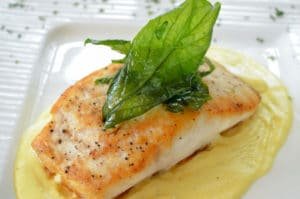By Anne Palumbo
 Here’s a quarantine surprise: More people are cooking seafood, especially now that certain meat products are becoming harder to find.
Here’s a quarantine surprise: More people are cooking seafood, especially now that certain meat products are becoming harder to find.
Here’s a surprise of a different nature: Snapper, a popular white fish with a firm texture and a distinctive sweet, nutty flavor, has a nutritional profile that’s bound to intrigue.
To begin, snapper is an excellent source of lean, high-quality protein, with an average serving delivering about 40% of our daily needs. What makes snapper’s protein particularly attractive is that, unlike, say, a comparable serving of ground beef, it’s much lower in fat, calories and sodium. What’s more, it has an admirable water footprint: snapper, 0 gallons; one hamburger, 450-600 gallons. We need protein to build and repair tissues, regulate hormones and increase feelings of fullness.
Snapper is a vitamin B12 superstar. This high-priority vitamin helps to produce red blood cells and DNA, keep nerves healthy, promote bone health and synthesize serotonin — the “happiness” chemical. Many studies support that vitamin B12 may boost energy, slow mental decline and improve moods. Since many older people suffer from a B12 deficiency — whether through diet or poor absorption — it’s good to know that seafood is a great source of this essential B vitamin.
Another nutritious hook? An average serving of snapper contains 50% of our daily needs for selenium. A powerful antioxidant that helps prevent cell damage, selenium is required for the thyroid gland to work properly and plays an important role in the health of our immune system.
This flavorful fish is also a good source of omega-3s — healthy fats that have been linked to a lower risk of many life-threatening conditions. According to experts at the Cleveland Clinic, omega-3s have been shown to increase levels of good cholesterol and reduce blood clots, blood pressure, and inflammation.
While all fish, including snapper, contain some cholesterol, they can still be part of a heart-healthy diet. The good news is, it’s the saturated fat in food that raises blood cholesterol levels, not so much the dietary cholesterol, and snapper is super low in saturated fat. It’s also relatively low in cholesterol: an average serving of snapper, 37 mg of cholesterol; an average serving of shrimp, 190 mg.
As for its mercury levels, snapper is a “good choice” to eat once a week, according to the FDA. This advice is particularly helpful for women who are pregnant, breastfeeding mothers, and young children.
Grilled Red Snapper with Black Beans
Serves 4
1 teaspoon olive oil
2 red snapper fillets (halved)
1 teaspoon paprika
1/4 teaspoon cayenne (optional)
1 teaspoon salt
1/2 teaspoon garlic powder
1 teaspoon dried thyme
1 teaspoon dried oregano
1/2 teaspoon coarse black pepper
15 oz. can black beans, rinsed and drained
3 tablespoons chopped red onion
1 garlic clove, minced
1 tablespoon olive oil
2 teaspoons red wine vinegar
1 teaspoon Dijon mustard
1/2 teaspoon salt
1/4 teaspoon coarse black pepper
Lightly coat both sides of snapper with olive oil. Mix together the paprika, cayenne, salt, garlic powder, thyme, oregano and black pepper. Sprinkle over each side of the red snapper. Set aside.
Before grilling, coat your grates with a high-heat cooking oil, such as canola oil (spray or a paper towel coated with oil will work). Do the same if using a grill pan. Preheat the grill to high heat for 10-15 minutes.
While grill is preheating, combine the beans, onion, garlic, olive oil, vinegar, mustard, salt and pepper in a medium saucepan. Cook, uncovered, over low heat for 10 minutes, stirring occasionally. Remove from heat and cover.
Grill the snapper about 5 to 6 minutes on each side or until the fish reaches an internal temperature of 145 F. Serve topped with black bean mixture.
(No grill? Heat 2 tablespoons canola oil in a large skillet over medium-high heat. Place snapper fillets in skillet and cook about 5 minutes on each side.)
Helpful tips
Snapper fillets are readily available fresh and frozen. Fresh fish should be cooked the day it is purchased; however, it will keep for two days in the refrigerator if properly wrapped. Although it’s best to eat snapper the day it’s prepared, any leftovers will last three to four days in the refrigerator. Using a “grill pan” facilitates cooking snapper on the grill.
Anne Palumbo is a lifestyle columnist, food guru, and seasoned cook, who has perfected the art of preparing nutritious, calorie-conscious dishes. She is hungry for your questions and comments about SmartBites, so be in touch with Anne at avpalumbo@aol.com.

